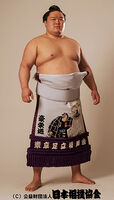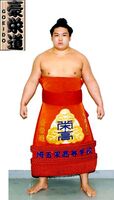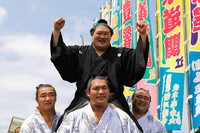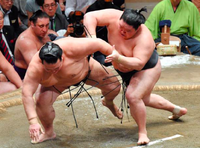Goeido Gotaro - 豪栄道 豪太郎 (born April 6, 1986) is a former Japanese professional sumo wrestler from Neyagawa, Osaka. He made his debut in January 2005 and wrestled for Sakaigawa stable. He reached the makuuchi division in September 2007 and has 11 special prizes, 1 kinboshi and 1 top division championship. His highest rank was ozeki and he retired in January 2020.
Early Life[]
Born in Neyagawa, Sawai began sumo in his first year of primary school. He was well known for being a strong contender from the beginning, and was encouraged by his family to take on older and bigger boys to improve his sumo even further. In junior high his light weight compared to most of his contemporaries held him back and demoralized him. However, he made the decision to attend Saitama Sakae High School which had a well-known sumo program. With a new found determination and a supportive coach, he won 11 national titles. At the 53rd All Japan Sumo Championships held at the Ryogoku Kokugikan in December 2004, in which he was the only high school student to compete, he finished in the top four. He made his professional debut one month later in January 2005, joining Sakaigawa stable.
Career[]
Early Career[]
Sawai made his debut in January 2005 and rose up the ranks quickly. He took the jonokuchi yusho with a perfect 7-0 record. The following tournament in jonidan, he finished with a strong 6-1 record. After that, he produced another 7-0 record for the sandanme yusho and earned a promotion to makushita.
He made his makushita debut and finished with a mediocre 4-3 record. The following tournament he finished with a 7-0 record and took the makushita championship. He was promoted to makushita 2, but the following two tournaments he produced 3-4 losing records, his first. He bounced back with two 4-3 records and in the September 2009 tournament he took his second makushita yusho with a perfect 7-0 record. This earned him a promotion to juryo and upon his promotion he changed his shikona to 'Goeido'.
Juryo Career[]
In his juryo debut, Goeido produced a less than ideal 8-7 record. He produced another 8-7 record the following tournament and was promoted back to jute 9 for the March 2007 tournament. He produced a spectacular 11-4 record and was promoted up to juryo 3, however he posted a 6-9 record. This brought him down to juryo 5, but he bounced back with a 12-3 runner-up score after losing the playoffs against Iwakiyama. This was good enough to earn him a promotion to makuuchi.
Makuuchi Career[]
He had a very successful top division debut, leading the race for the championship after the 11th day with a score of 10–1. Pitted against higher ranked opposition on the next three days, he lost to Ama, ozeki Chiyotaikai and yokozuna Hakuho. He was the first makuuchi debutant to face a yokozuna since Tosanoumi in 1995. He ended the tournament with an 11–4 score and was awarded the Fighting Spirit prize. In the November tournament he won six of his first seven bouts, and though he began losing in the second week he still finished with a majority of wins (8–7).

Goeido defeats Asashoryu for his first and only kinboshi (c. 2010)
He was promoted up the ranks to maegashira 3 in January 2008. For this tournament he faced all the top-ranked men at the beginning instead of during the second week as had been the case in his debut. He fell short with five wins against ten losses, although did upset ozeki Kotomitsuki on the third day. After this tournament he was named as one of seven wrestlers who NHK commentator Shuhei Nagao (the former Mainoumi) called the "Seven Samurai" and identified as "holding the key" to a Japanese resurgence in sumo, which was dominated by foreigners in the top ranks. (The others were his stablemate Toyohibiki, Kisenosato, Kotoshogiku, Homasho, Toyonoshima and Tochiozan). Back at maegashira 8 for the March 2008 tournament, he clinched his kachi-koshi score of 8–7 with victory on the final day. He produced the same score in the May 2008 tournament, in which his best result was a victory over tournament runner-up Toyonoshima.
In the September 2008 tournament he was the tournament co-leader with only one loss up to Day 10, although he lost four of his last five matches. He did defeat tournament runner-up Ama for the first time on Day 14 and finished with a strong 10–5 record. He was awarded his second Fighting Spirit prize and was promoted to a san'yaku position at komusubi for the November 2008 tournament. He could only win one bout in the first ten days (over Ama once again) and finished with a 5–10 score.

Goeido prepares for his upcoming match (c. 2011)
In the January 2009 tournament he won ten bouts from the maegashira 3 ranking, earning his first Technique prize and promotion back to komusubi. His second attempt at komusubi, in his hometown tournament, proved more successful and he compiled a 9–6 score which included a first win in five attempts over Kotooshu and two other victories over ozeki. This earned him promotion to sekiwake for the first time for the May 2009 tournament. He began the tournament brightly, defeating three ozeki in the first three days (the best start by a new sekiwake since Tochinowaka in September 1987), but he faded after that and recorded a disappointing 6–9. Ranked at maegashira 1 in July, he could only score 5–10. In August he had endoscopic surgery on his right elbow. Despite this, he fought his way to a 10–5 record in the September tournament after a poor start, and returned to komusubi for the Kyushu tournament in November. After scoring only seven wins there he was demoted back to the maegashira ranks.
In January 2010 he earned his first kinboshi by defeating Asashoryu on Day 5. This was his first victory over a yokozuna, discounting a win by default in September 2008. However a defeat to Aminishiki on the final day meant he finished on 7–8 and he missed out on the Outstanding Performance prize as a result. He was forced to pull out of the March tournament, his first career withdrawal, after injuring his left knee in a defeat to Homasho Noriyuki on Day 5.
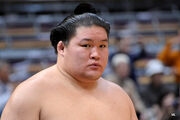
Goeido awaits for his upcoming match (c. 2012)
He was suspended along with over a dozen other wrestlers from the July 2010 tournament after admitting involvement in illegal betting on baseball. As a result, he fell to the juryo division in September. Ranked at juryo 1 he had no problem in securing an immediate return to the top division by scoring 12–3. In the May 2011 'technical examination' tournament he defeated all four ozekiand was awarded his second Technique prize. His 11–4 score meant he scored double-digit wins from the maegashira ranks in three consecutive tournaments, a feat previous achieved by only three wrestlers (Yoshibayama, Dewanishiki and Wakachichibu) and not seen for 49 years. However, his return to the san'yaku ranks in the July 2011 tournament was unsuccessful as he lost eight of his first nine bouts, finishing on 5–10.
Goeido's best result for some time came in the March 2012 tournament in Osaka, where he finished on 12–3 and won his third Fighting Spirit award. He was promoted to sekiwake for the second time, three years after his debut at the rank. During the tournament he defeated Hakuho for the first time in 14 attempts, handing the struggling yokozuna his third defeat of the basho. He also defeated three ozeki during the tournament and was awarded his first Outstanding Performance Prize. In the November 2012 tournament Goeido achieved double digit wins in a san'yaku rank for the first time, scoring 11–4 and winning his third Technique Award. He remained at sekiwake for the July 2013 tournament despite only scoring seven wins in May, because of the lack of qualified candidates to take his slot. This had also been the case in September 2012, and Goeido is the first wrestler to see this happen to him twice.

Goeido throws Yokozuna Harumafuji (c. 2014)
Goeido finished runner-up to Kakuryu on 12–3 and won his third Outstanding Performance Prize. In the July 2014 tournament, he logged his fourteenth consecutive appearance at sekiwake a modern age record, passing up Kaio's thirteen. He finished 12–3, beating two yokozuna and two ozeki and earning another Outstanding Performance Prize (his 3rd in a row).
Ozeki Career[]
In recognition of his continued outstanding performance at sekiwake he was promoted to ozeki for the September 2014 tournament despite having a mediocre 8–7 record in the May tournament and only 32 wins in his last 3 tournaments when 33 is generally the standard for promotion. He turned in an unimpressive 8–7 (with one win by default) in his ozeki debut followed by a disastrous 5–10 in the November tournament, leaving him in danger of demotion (kadoban) in the upcoming January 2015 tournament. A 7–8 record in September 2015 saw him kadoban for the second time in less than a year. After recording wins over Terunofuji, Kakuryu and Kisenosato he escaped demotion on the final day of the November 2015 tournament with a victory over Tochiozan which saw him end with an 8–7 record. However, another losing record (4–11) in January 2016 meant he would be kadoban for the third time in the March 2016 tournament. Fighting in front of his hometown supporters Goeido produced a career best effort to record 12 wins including victories over the yokozuna Kakuryu and Harumafuji and was in contention for the championship until losing to Kisenosato on the final day. It was the first time in his ozeki career that had scored ten wins or more. He managed nine wins in May but a defeat to Kisenosato on the final day of the July tournament saw him kadoban for the fourth time.

Goeido celebrates his first and only makuuchi yusho (c. 2016)
In September 2016 Goeido started strongly with six straight wins including victories over komusubi Tochiozan and both sekiwake (Takarafuji and Takayasu). He gained the sole lead in the tournament with a victory over Okinoumi on day seven and went on to secure his ozeki rank by beating Yoshikaze a day later. In the tournament's second week he maintained his unbeaten run with wins over his fellow ozeki Terunofuji and Kisenosato and the yokozuna Kakuryu to open up a two-win lead over his rivals. On day thirteen he defeated Harumafuji with a neck throw (kubinage) meaning that he needed only one win in the last two days to secure his first tournament victory. On September 24, the penultimate day of the tournament Goeido clinched the title with a force-out (yorikiri) win over Tamawashi. After his win he commented, "I just focused on wrestling as hard as I could. I’m really happy. There was a time when things didn’t go my way, but I’m glad I stuck it out. I concentrated on my performance and took it one bout at a time, which led to this result". When asked about his prospects of advancing to yokozuna he added "I really can't think about it right now. I want to soak up the moment for a little bit". He was the first wrestler from Osaka to win a top division championship since Yamanishiki in 1930. On the final day he completed a zensho-yusho with a win over Kotoshogiku. He was the first wrestler to win his first championship with a 15–0 record since Musashimaru in 1994, at 30 years five months he was the fifth oldest first-time yusho winner, and he was the first to win with a 15–0 record as a kadoban ozeki.
Goeido won his first five bouts in the following Kyushu tournament, but then was defeated by komusubi Tamawashi on Day 6. On Day 8 against sekiwake Okinoumi he was forced to the edge of the ring but with his left heel back on the straw bales he threw his opponent down. The referee awarded the bout to Goeido but the judges overruled his decision, with the chief judge Tomozuna announcing to the crowd that in his opinion Goeido's body was already out of the ring (shini-tai) before Okinoumi hit the ground. Goeido's promotion hopes were ended by a third defeat to fellow ozeki Kisenosato on Day 9. Goeido went on to win the next three days, but then lost the final three days where he faced all three yokozuna. Goeido finished the tournament with a 9–6 record, dashing his hopes of perhaps being under consideration for promotion in January.

Goeido towards his later career (c. 2020)
He withdrew from the January 2017 tournament on Day 13 having injured his right ankle in a defeat to Endo the previous day. His withdrawal gave a win by default to the tournament leader Kisenosato. He was still troubled by the injury in the March tournament in Osaka and pulled out on the sixth day having suffered four straight losses. He retained his status with nine wins in May but went kadoban for the sixth time after a 7–8 record in July. The September 2017 tournament saw Goeido as the only ozeki participant with Takayasu withdrawing on Day 3 and Terunofuji on Day 6. After losing his opening match he then won ten in a row to stand as the clear tournament leader on 10–1, two wins ahead of rank-and-filers Chiyotairyu, Asanoyama and Takanoiwa on 8–3. He lost two of his next three matches but still went into the final day one win ahead of the only yokozuna in the tournament, Harumafuji. However, Harumafuji defeated him twice, once in their regulation match and again in a playoff after both finished with 11–4 records. Although he missed out on his second yusho this was Goeido's first runner-up performance as an ozeki and only the third time he has recorded double-digit wins at the rank. He withdrew from the May 2018 with an ankle injury after suffering five defeats in the first eight days. With his fellow ozeki Takayasu also absent, this marked the first time since 15-day tournaments began in 1949 that two ozeki had withdrawn. In September 2018 he was a runner-up for the second time as an ozeki, and seventh time in his career, with a 12–3 record. He withdrew on Day 12 of the following tournament in November with a right arm injury, having already secured his majority of wins. He produced a 12–3 score in March 2019, although it was only good enough for third place behind Hakuho on 15–0 and Ichinojo on 14–1. In July he withdrew from the tournament on Day 7 having already suffered four defeats, citing a right shoulder injury. He withdrew from the November 2019 tournament after sustaining a left ankle injury in his opening day defeat to Endo.
Rivalry with Tochiozan[]
Goeido joined professional sumo at the same time as Tochiozan, who Goeido had fought a number of times in high school amateur sumo competitions and regarded as his chief rival. In his first professional bout on 15 March 2005 Goeido defeated Tochiozan who was also making his debut. He reached sekitori status one tournament later than Tochiozan, who also preceded him into the top division. Goeido made his sekiwake debut in the same tournament that Tochiozan made his debut at komusubi. In their head-to-head clashes in professional sumo, Goeido led 25–14, including a win by default, and won their last six encounters until a day 3 defeat in the 2018 Kyushu Basho.
Retirement from Sumo[]

Takekuma Oyakata (c. 2023)
Entering the January 2020 tournament as a kadoban ozeki, Goeido suffered his eighth loss in his Day 12 match against Asanoyama. He chose to retire rather than be demoted to sekiwake for the March 2020 tournament in his native prefecture of Osaka. The Sumo Association's head of Public Relations, Shibatayama Oyakata said on 27 January that he had received word of Goeido's decision from his stablemaster, Sakaigawa, and the following day it was confirmed that Goeido would be taking the toshiyori name of Takekuma Oyakata. He was the first to retire at the ozeki rank since Kaio in 2011, and this left only one ozeki on the banzuke for the first time in 38 years. Goeido retired having been ozeki for 33 straight tournament, the tenth highest in history. At a press conference on 29 January he said, "A few years back, I promised myself I'd retire when I fell from ozeki rank. So there was no doubt in my mind."
Goeido's danpatsu-shiki, or retirement ceremony, was planned to be held at the end of January 2021 at the Ryogoku Kokugikan following that month's sumo tournament, but it was postponed due to the COVID-19 pandemic. The ceremony was eventually held two years after his retirement on 29 January 2022.
Shortly before his rescheduled retirement ceremony, it was announced that Goeido was approved to open his own stable, Takekuma stable.
Controversy[]
Gambling Scandal[]
Goeido was suspended along with over a dozen other wrestlers from the July 2010 tournament after admitting involvement in illegal betting on baseball. As a result, he fell to the juryo division in September.
Personal Life[]
- Goeido's hobbies include watching mixed martial arts (MMA) and reading comic books and magazines. He is a big fan of Yomiuri Giants, which is a Japanese baseball team based in Bunkyo, Tokyo.
- His favorite food is beef. He dislikes fresh fish, natto (fermented sticky soybeans), and pickles.
Fighting Style[]
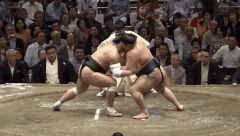
Goeido defeats Harumafuji by kubinage (headlock throw)
Goeido was a yotsu-sumo wrestler, preferring grappling rather than pushing or thrusting techniques. His preferred grip on his opponent's mawashi was migi-yotsu, a left hand outside, right hand inside position. His most common winning kimarite was yorikiri, or force out, but he used a wide variety of techniques in his career, including sotogake, an outer leg trip, and kubinage, the neck throw.
Record[]
Division Results[]
- Total: 696-493-66/1180 (90 basho)
- Makuuchi: 587-442-66/1020 (73 basho)
- Juryo: 57-33/90 (6 basho)
- Makushita: 32-17/49 (7 basho)
- Sandanme: 7-0/7 (1 basho)
- Jonidan: 6-1/7 (1 basho)
- Jonokuchi: 7-0/7 (1 basho)
Championships[]
- 1 Makuuchi Championship (September 2016)
- 2 Makushita Championships
- 1st (November 2005)
- 2nd (September 2006)
- 1 Sandanme Championship (July 2005)
- 1 Jonokuchi Championship (March 2005)
Achievements[]
- Special Prizes: Outstanding Performance Prize (5), Fighting Spirit Prize (3), Technique Prize (3)
- Kinboshi: (1) Asashoryu
- Record: 1st Most consecutive sekiwake appearances (14)
- Record: 10th Most tournaments ranked at ozeki (33)
- Record: Tied for 12th: Most Special Prizes (11)
Shikona History[]
- Sawai Gotaro (2005.01 - 2006.09)
- Goeido Gotaro (2006.11 - 2020.01)


